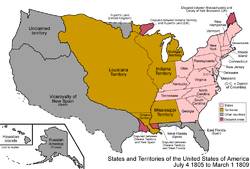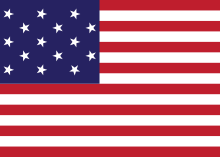Louisiana Territory
| Territory of Louisiana | |||||
| Organized incorporated territory of the United States | |||||
| |||||
|
| |||||
 | |||||
| Government | Organized incorporated territory | ||||
| Governor | |||||
| • | 1805-1807 | James Wilkinson | |||
| • | 1807–1809 | Meriwether Lewis | |||
| • | 1813–1820 | William Clark | |||
| History | |||||
| • | Established | July 4, 1805 1805 | |||
| • | Renaming at Louisiana's Statehood | June 4, 1812 1812 | |||
The Territory of Louisiana or Louisiana Territory was an organized incorporated territory of the United States that existed from July 4, 1805, until June 4, 1812, when it was renamed the Missouri Territory.
Louisiana Territory was formed out of the Indiana Territory -administered District of Louisiana, which consisted of all Louisiana Purchase lands north of the 33rd parallel. The 33rd parallel now forms the southern border of Arkansas and the northern border of Louisiana. The territory's predecessor, the District of Louisiana, as well as the District of Orleans, were formed from the lands acquired by the United States in the Louisiana Purchase, in which colonial Louisiana was purchased from France.
Background
The Eighth Congress of the United States on March 26, 1804, passed legislation entitled "An act erecting Louisiana into two territories, and providing for the temporary government thereof,"[1] which established the Territory of Orleans and the civil District of Louisiana.
This act, which went into effect on October 1, 1804, expanded the authority of the governor and judges of the Indiana Territory to provide temporary jurisdiction over the District of Louisiana.
Establishing the Louisiana Territory
On March 3, 1805, Congress enacted legislation organizing the District of Louisiana into the Louisiana Territory, effective July 4, 1805.
The Territory was governed similarly to Indiana Territory.[2]
Boundaries
The Louisiana Territory included everything in the Louisiana Purchase north of the 33rd parallel (the southern boundary of the present state of Arkansas).
The southern and western boundaries with Spanish Texas and New Mexico were not fully defined until the Adams–Onís Treaty of 1819.
Subdivisions
The Louisiana Territory had five subdivisions: St. Louis District, St. Charles District, Ste. Genevieve District, Cape Girardeau District, and New Madrid District.
In 1806, the territorial legislature created the District of Arkansas from lands ceded by the Osage Nation. The remainder was known as the Upper Louisiana Territory.
Government
The seat of government was in the town of St. Louis.
The first territorial governor was James Wilkinson, appointed by President Jefferson and concurrently holding the position of Senior Officer of the United States Army.
Meriwether Lewis (1807–1809) and William Clark (1813–1820) served as the second and third Louisiana Territory governors, respectively.
Renamed as Territory of Missouri
On June 4, 1812, the Twelfth U.S. Congress enacted legislation which renamed Louisiana Territory as Missouri Territory, in order to avoid confusion with the recently admitted State of Louisiana.[3]
See also
- Historic regions of the United States
- History of Missouri
- Territorial evolution of the United States
- Territories of Spain that encompassed land that would later become part of the Territory of Louisiana:
- Santa Fé de Nuevo Méjico, 1598–1821
- Tejas, 1690–1821
- Luisiana, 1764–1803
- Territory of France that encompassed land that would later become part of the Territory of Louisiana:
- Louisiane, 1682–1764 and 1803
- U.S. territories that would later become part of the Territory of Louisiana:
- Louisiana Purchase, 1803–1804
- District of Louisiana, 1804–1805
- U.S. territories that included territory that was previously part of the Territory of Louisiana:
- Territory of Missouri, 1812–1821
- Territory of Arkansaw, 1819–1836
- Indian Territory, 1834–1907
- Territory of Iowa, 1838–1849
- Territory of Minnesota, 1849–1858
- Territory of New Mexico, 1850–1912
- Territory of Kansas, 1854–1861
- Territory of Nebraska, 1854–1867
- Territory of Colorado, 1861–1876
- Territory of Dakota, 1861–1889
- Territory of Montana, 1864–1889
- Territory of Wyoming, 1868–1890
- Territory of Oklahoma, 1890–1907
- U.S. states that include territory that was once part of the Territory of Louisiana:
- State of Missouri, 1821
- State of Arkansas, 1836
- State of Texas, 1845
- State of Iowa, 1846
- State of Minnesota, 1858
- State of Kansas, 1861
- State of Nebraska, 1867
- State of Colorado, 1876
- State of North Dakota, 1889
- State of South Dakota, 1889
- State of Montana, 1889
- State of Wyoming, 1890
- State of Oklahoma, 1907
- State of New Mexico, 1912
- Territories of Spain that encompassed land that would later become part of the Territory of Louisiana:
- Territorial evolution of Canada
- Provinces of Canada that encompass land in the Missouri River drainage basin:
- Saskatchewan, 1905
- Alberta, 1905
- Provinces of Canada that encompass land in the Missouri River drainage basin:
References
- ↑ "An act erecting Louisiana into two territories, and providing for the temporary government thereof". United States Statutes at Large. Eighth Congress, Session I, Chapter 38, March 26, 1804, pg. 283–289. From Library of Congress, A Century of Lawmaking for a New Nation: U.S. Congressional Documents and Debates, 1774–1875. (accessed December 14, 2008)
- ↑ "An Act further providing for the government of the district of Louisiana". United States Statutes at Large. Eighth Congress, Session II, Chapter 31, March 3, 1805, pg. 331–332. From Library of Congress, A Century of Lawmaking for a New Nation: U.S. Congressional Documents and Debates, 1774–1875. (accessed December 14, 2008)
- ↑ "An Act providing for the government of the territory of Missouri". United States Statutes at Large. Twelfth Congress, Session I, Chapter 95, June 4, 1812, pg. 742–747. From Library of Congress, A Century of Lawmaking for a New Nation: U.S. Congressional Documents and Debates, 1774–1875. (accessed December 14, 2008)
